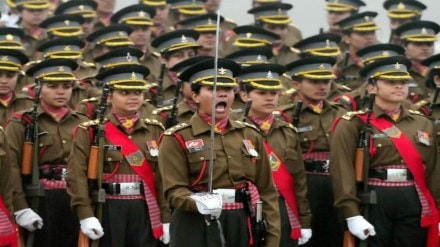In India, women have always lived a reverse life, starting from the medieval era of being equally involved in all courses of life to the modern era of advocating to be included in all.
“In Indian scriptures, women have enjoyed an equal role; in mythology, if you see, gods and goddesses during worship are given equal platforms; even couples sit together while performing any pooja.” Dr. Madhuri Kanitkar, former Lieutenant General, Indian Army, told Financial Express online.
Combat is one of the roles that a modern woman is trying to fit into. In India, women were introduced to the armed forces During the World War. They have walked a long way to represent their part in the Armed Forces and National Security, equally as their male counterparts, but there is still a long way left for them to walk on.
In 1888, the British Indian Army (BIA) started to include women in the military branch because of the lack of male doctors during World War I. Women were introduced as nurses in the hospitals.
Kanitkar said, “During the world war, they found male doctors were not enough, so they included women as nurses, and at that time, women used to work in hospitals, and male doctors were sent upfront.”
Expanding women’s roles, the British established the Women’s Auxiliary Corps, which permitted them to serve in non-combatant roles such as accounting, communications, and administration.
Azad Hind Fauj, formed by Subhash Chandra Bose, had a women’s regiment known as the Rani of Jhansi Regiment, which saw active combat while fighting with the Imperial Japanese Army in Burma.
Up until 1958, they were ineligible for regular commission in all forces in all roles after the Army Act of 1950. In 1958, they were given regular commission in the Indian Army Medical Corps.
“Starting from there, look where we’ve come today; now women doctors are serving upfront; they are even posted at high-altitude locations and Siachen base camp as well.” Kanitkar favoured the moving stance of women in the armed forces.
In the midst of this, women spies were quite famous: Noor Inayat Khan during World War II and Sehmat during the Indo-Pak war, on which the 2018 Bollywood movie Raazi is inspired.
Power is a term synonymous with Shakti, the Hindu goddess of power, who also represents women. Still, modern women have to walk onto a long path. Even now they are trying hard to prove their strength to be involved in all roles.
Later, the journey moved to the year 1992; meanwhile, the spark was lit even before that. In 1992, they were given short-service roles other than playing the soft roles of nurses, and medical roles.
Even from 1992 on, the journey for women in India to be included in national security is long. The recent PTI data reveals that in India, which has one of the world’s largest militaries, only 4% of its army accounts for women out of more than one million members.
Previously, in a similar article, FE Online discussed the reason why India is included in the majority of countries that employ women in various military roles but not in combat roles, but excluded from those few that include them.
The idea that came out reveals the process and requirements of the roles as per the raised voices. In 2020, the Supreme Court ruled to grant permanent commissions to short-service commissioned women officers and provide them with commanding roles. New avenues identified include the induction of women cadets into the NDA and recruiting women as “provost JCOs/OR.”.
Women are currently being commissioned in the Indian Army in ten streams, including the Corps of Engineers, Corps of Signals, Army Air Defense, Army Service Corps, Army Ordnance Corps, Corp of Electronics and Mechanical Engineers, Army Aviation Corps, Intelligence Corps, Judge Advocate General Branch, and Army Education Corps, as well as the Armed Forces Medical Services as Doctors and Military Nurses, which is open only to women.
The Indian Air Force allows them selective fighter roles, and the Indian Navy is also stepping forward towards women’s inclusion. In 2019, the first woman pilot, Sub-Lieutenant Shubhangi Swaroop, gained a role in flying the Dornier 228 surveillance aircraft for the Indian Navy.
Kanitkar concluded, “Gradually, society has also started to accept and respect women; the traditional role of women in rural India has started to change again; those women will encourage others.”.
In a huge step toward gender inclusion, the Indian Army is actively considering enlisting women as jawans, further expanding their representation in the military. This revolutionary approach comes after their effective integration into the Corps of Military Police, and recently, on March 15, the third batch of Agniveers passed from INS Chilka with 2,630 Agniveers, including 396 women.
